Dusty Miller: Complete Plant Care Guide (With Flower Pictures)

Dusty miller (Senecio cineraria, syn. Jacobaea maritima) is an attractive bushy perennial flowering shrub with silvery gray, soft fuzzy lobed leaves. As a minimal care bedding plant, dusty miller plants are drought tolerant and withstand direct sunlight, drought, and frost. The only care the plant needs is to trim leggy dusty miller stems in the summer.
Also called silver ragwort, dusty miller is an ideal herbaceous plant to add contrasting colors to a summer garden. The silvery lobed leaves stand out against darker foliage plants and colorful flowering shrubs. Growing around 2 ft. (0.6 m) tall, dusty miller is also perfect as a ground cover plant for full sun in warmer climates.
This article is a comprehensive care guide for the silver dusty miller plant. Do you want to plant this shrubby silvery plant in the ground to enhance your garden landscape? Or do you want to grow dusty miller in containers to beautify a patio, deck, or balcony? You will find all you need to know about growing dusty miller plants.
How to Care for Dusty Miller
To care for dusty miller, grow silver ragwort in full sun and soil that has excellent drainage. As a drought-tolerant perennial plant, dusty miller requires occasional watering to grow strong. Provide soil nutrients by working in compost to the ground and prune leggy stems in midsummer to improve the plant’s appearance.
Dusty Miller Plant Facts
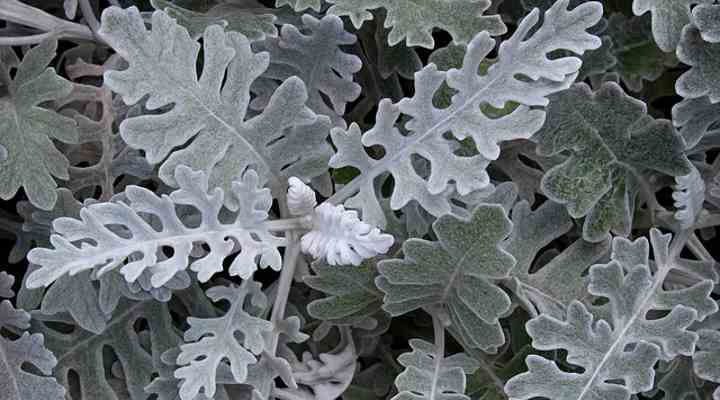
Dusty Miller (Senecio cineraria / Jacobaea maritima) adds decorative touch with it’s furry silvery foliage
Dusty miller is an ornamental shrubby plant native to the Mediterranean. The plant is identified by its silvery lobed leaves that have fine hairs and yellow flowers. As the dusty miller plant matures, the fuzzy stems become stiff and woody.
Dusty miller thrives in USDA zones 7 through 10. The drought-tolerant plant grows as a tender perennial in warm climates. In colder climates, you can grow dusty miller as an annual bedding plant. Although not very cold-hardy, it will tolerate some light frost. Annual dusty miller plants rarely grow more than 1 ft. (30 cm) tall.
Dusty miller has the botanical name Senecio cineraria and belongs to the family Asteraceae. However, many botanists now classify the shrub as Jacobaea maritima. Apart from its common name ‘dusty miller,’ the fuzzy shrub is also called silver ragwort, silver dust, or maritime ragwort.
Dusty Miller Flowers
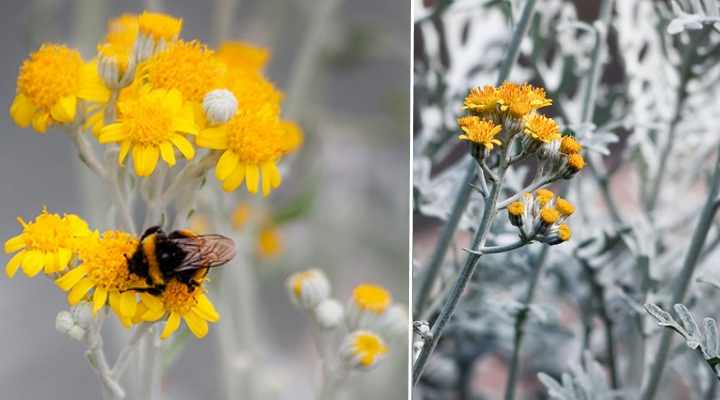
Close-up picture of dusty miller flowers – Dusty Miller has clusters of small yellow flowers
Dusty miller is a flowering shrub that produces clusters of small yellow daisy-like flowers. Dusty miller has golden yellow flowers that usually appear on the plants during the first year. However, dusty miller flower clusters are relatively insignificant, and most gardeners remove the flowers to encourage foliage growth.
Dusty miller flower heads grow between 1” and 3” (2.5 – 7.5 cm) across.
Dusty Miller Leaves
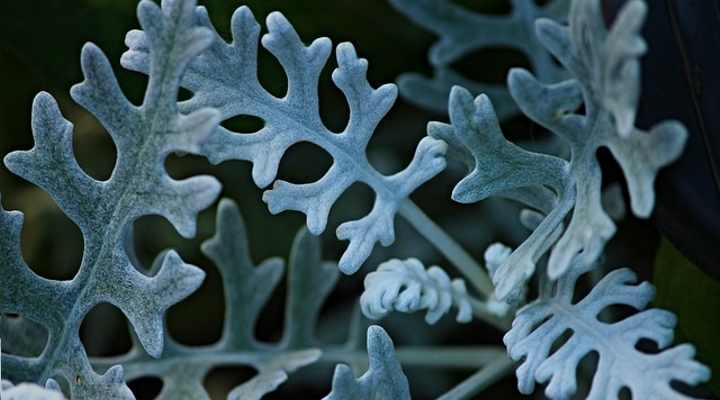
Dusty Miller plant has fuzzy silvery-gray leaves that are deeply lobed
The striking feature of dusty miller plants is its unusual silvery leaves covered in fine hairs. Dusty miller silver wooly leaves are lance-shaped and feature deep lobes or scalloping on the margins, typical of ragwort plants. Leaves grow 3” to 6” (7.5 – 15 cm) long and up to 3” wide.
The soft fuzzy, silvery leaves help to retain moisture and make the shrub tolerant of summer heat. The felted appearance of dusty miller leaves disappears when they are wet. Also, leaves may lose their silvery look when growing in the shade.
Where to Plant Dusty Miller
Dusty miller should be planted in the sunniest part of your garden. Due to its shrubby nature and low growth, dusty miller is an ideal plant for beds and borders, rock gardens, or mass plantings. The attractive gray-silver foliage looks spectacular in a garden landscape growing beside red, pink, or purple flowers and creeping annuals.
Because of its tolerance for drought, dusty miller is ideal for planting in a xeriscape garden.
Depending on your landscaping needs, silver ragwort can be grown in containers. This way, you can have the attractive plants in a backyard, on a patio, or to enhance an entranceway. Additionally, you can bring container plants indoors to winterize them.
When planting dusty miller in your garden, ensure to space the plant between 1 and 3 ft. (0.3 – 1 m) apart. This gives the silvery bushy foliage room to grow. It also prevents mold on the leaves forming due to a lack of air circulation.
Dusty Miller Plant Care Guide
Here are the best tips and advice on successfully growing silver dust plants (Senecio cineraria) in your garden
Dusty Miller Sun Requirements
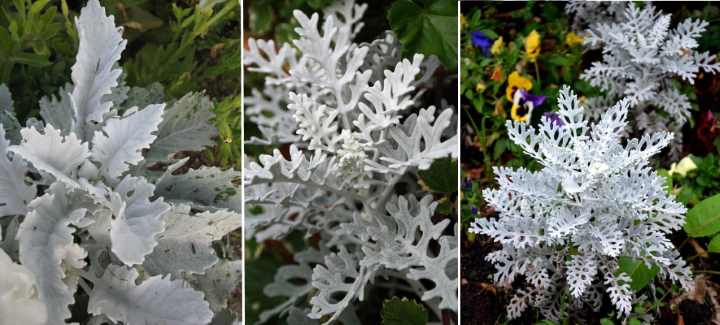
To care properly for Dusty Miller plants, grow them in the sunniest part of your garden
Silver dust plants grow best in full sun or partial shade. Ideally, dusty miller needs at least six hours of sunlight daily to thrive. Getting plenty of sunshine keeps the plant’s growth compact with vibrant, silvery wooly foliage. Avoiding complete shade prevents leggy growth.
If you live in areas with extremely hot summers, then planting dusty miller in partial shade is ideal. Some midday protection from intense sunlight prevents the leaves from scorching. In hot, sunny weather it may be necessary to water the silver ragwort plants more often.
Because dusty miller is drought and heat tolerant, you don’t have to worry much about too much sunlight or little water.
Best Soil for Silver Dust (Dusty Miller) Plants
Dusty miller grows best in most types of soil as long as there is excellent drainage. Even though it’s not a thirsty plant, it’s important to amend the soil with compost to provide nutrients and retain moisture.
The beauty of growing dusty miller in a garden landscape is that it grows almost anywhere. If you’ve got sandy, rocky soil, then silver dust plants will thrive. For example, if you have a xeriscape garden, this plant will do well alongside other low-water plants in sandy soil.
If the planting area has poor drainage, then you will have to amend the soil to grow dusty miller successfully. Waterlogged ground leads to root rot and will kill your beautiful silver dust shrub. To improve drainage, work in perlite or gravel before planting.
How to Water Dusty Miller
Once established, dusty miller only requires occasional watering. During mild spring and summer weather, you may only have to give about 1” (2.5 cm) of water a week. In hot, arid conditions, you might need to thoroughly water silver dust plants twice a week. However, dusty miller survives well during drought.
Senecio cineraria is also a xeric plant that is suitable for xeriscape landscaping.
Top care tip for growing dusty miller: When watering silver ragwort, avoid splashing water on the silvery wooly leaves. Water can cause the furry coating to disappear from the leaves.
Temperature for Growing Dusty Miller in Your Garden
Dusty miller shrubs thrive in hot, sunny climates. However, the tender perennial will grow in temperatures as low as 40°F (4°C) and as high as 80°F (27°C). Being cold-hardy in USDA zones 7 through 10, dusty miller will tolerate light frost.
However, in colder climates, star dust plants grow best as annuals.
Dusty Miller Humidity Requirements
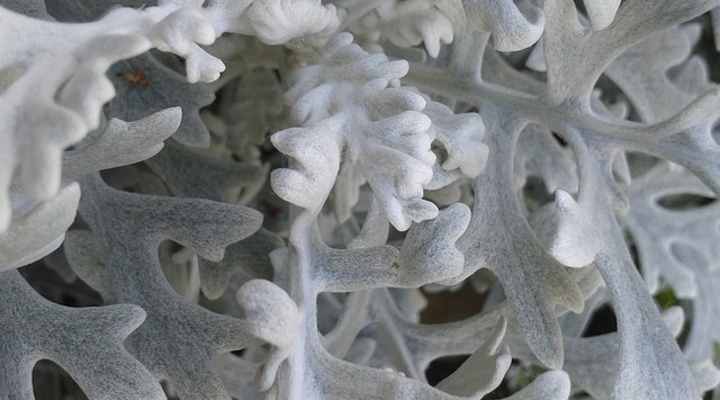
Dusty Miller plants grow well in dry climate and will benefit from spacing them to allow good air circulation
Dusty miller shrubs have few problems when it comes to humidity. Silver ragwort is native to the dry climate of the Mediterranean region and doesn’t need any particular care. The fuzzy growth on the leaves help to regulate the plant’s moisture levels.
To ensure that the dusty miller doesn’t suffer from excess air moisture, it’s crucial to space the plants properly. When planting dusty miller along borders, in mass plantings, or as foundation plants, plant them at least 1 ft. (30 cm) apart. Plenty of air circulation and occasional watering is all you need to keep the silvery bushes growing well.
How to Fertilize Dusty Miller
Silver dust plants can benefit from some light fertilization. However, Senecio cineraria are generally light feeders and only need extra nutrients when growing in extremely poor soil. To encourage healthy foliage, you can apply a slow release, general purpose fertilizer in spring.
The best way to boost the soil’s nutrient levels is to mix in leaf mold or well-rotted manure to the ground before planting.
Pruning Dusty Miller
Pruning can encourage bushy growth and control size when growing dusty miller as a tender perennial. In early spring, you can pinch off about 1” (2.5 cm) of new growth from each growing tip. New silvery stems will grow in the place. You can also prune the shrub in midsummer by removing about one-third of its height.
When growing silver ragwort as an annual, pruning is rarely necessary. The fast growth of the plant means that it quickly develops attractive fuzzy silver foliage. To bring out the best of the plant, you could snip off flowers as soon as they appear. This will concentrate the plant’s energy in growing new leaves.
Propagating Dusty Miller
You can propagate dusty miller plants by seed, stem cuttings, or root division. Seed takes the longest time to grow new Senecio cineraria plants and you should start growing them indoors. The best time to take stem cuttings is from new growth in spring. To propagate by root division, dig the plant up in the fall and divide the clump into two or more sections.
To grow dusty miller indoors from seed: Sow the seeds in light, moist potting soil about ten weeks before the last expected frost. Place in a bright, warm location that is between 65°F and 75°F (18°C – 24°C) to germinate. When the weather warms outside, plant the seedlings in the ground at least 12” (30 cm) apart.
To propagate dusty miller from stem cuttings: In spring, cut a 6-inch (15-cm) piece of stem. Dip the end in rooting hormone and put in a moist potting mix of peat moss and perlite. Cover with a plastic bag and put in a warm place. Transplant to your garden when new leaves start to grow.
Growing Dusty Miller in Containers
Silver ragwort or dusty miller is an ideal plant to grow in containers. The dramatic silvery foliage adds interest and visual appeal to other container plants and flowers. You can also grow dusty miller in hanging baskets along with flowering trailing plants.
Growing dusty miller in containers requires a light, porous potting mix. Combine one part houseplant soil, one part peat moss and one part perlite for the growing medium. Water dusty miller when the top layer of soil is dry. Put the pot in a bright location, protected from direct sunlight.
Top tip for growing silver dust plants in containers: You will need to water plants more frequently than growing in the ground.
Repotting Dusty Miller
Repotting dusty miller plants is necessary to prevent them from becoming root bound. Additionally, repotting perennials gives you a chance to refresh the potting soil and check for root damage. When repotting, always use a light potting mix that has excellent drainage.
Pest Affecting Dusty Miller Growth
Dusty miller is resistant to most pests that affect other plants in your garden. Sometimes, slugs can be a problem if the growing conditions are too damp. Also, aphids can cause growth issues if they are infesting other plants.
The best way to get rid of slugs is to hand pick them to stop them from destroying the silvery foliage. You can also try using beer traps to reduce a large number of slugs. However, letting the soil dry out or planting dusty miller in raised beds can help to keep slug numbers down.
If aphids are affecting plant growth, use an organic neem oil solution once a week. Liberally spray the leaves with neem oil to kill aphids from your garden plants. Please read this article to learn how to make your own neem oil natural pesticide.
Diseases Affecting Dusty Miller Growth
Root rot and powdery mildew are the most common diseases affecting dusty miller shrubs. You can usually avoid both of these problems by watering plants properly. Senecio cineraria is a drought-tolerant plant that only needs occasional watering.
To prevent dusty miller root rot, only water the ground when it’s completely dry. Depending on your climate, you may only need to water the shrub once a week or less. If drainage is an issue in your garden, plant dusty miller in raised beds or amend the ground with gravel to improve drainage.
Powdery mildew is a mold that grows on plant leaves. It looks like a white powdery substance and usually affects the lower leaves. While it may not kill the plant, it can look unsightly on garden plants, including dusty miller.
To prevent powdery mildew, always water the ground, not the plant’s leaves. Also, try to avoid water splashing on the leaves as this can cause fungal foliage issues.
Related reading: Four ways to prevent powdery mildew on plants.
Is Dusty Miller Toxic?
Dusty miller (Senecio cineraria or Jacobaea maritima) is on the list of toxic plants. According to the University of California, species in the genus Senecio can cause vomiting or diarrhea if ingested. Also, the sap from the plants can cause dermatitis.
Researchers also say that dusty miller is poisonous for cats, dogs, and horses. Because of its toxic properties, deer tend to stay away from dusty miller plants.
Dusty Miller Varieties
The difference between dusty miller varieties is their leaf shape. Some varieties have feathery fern-like leaves, whereas others have long leaves with scalloped margins. Some attractive dusty miller cultivars have fine, lace-like leaves.
Dusty Miller ‘Cirrus’

Cirrus dusty miller has broad, rounded silver-white leaves with roughly serrated margins.
Dusty Miller ‘Silverdust’
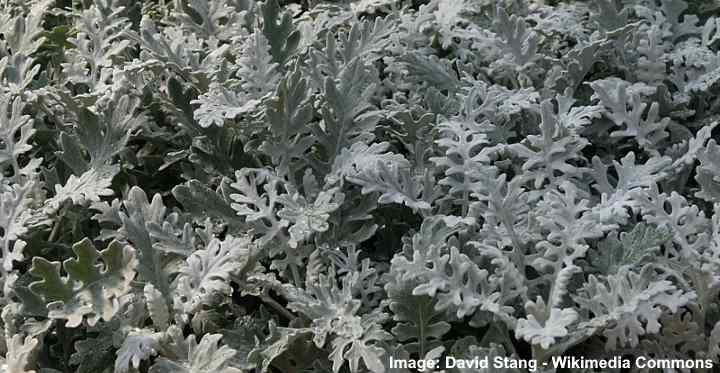
Silverdust is the most common type of dusty miller varieties for summer gardens. The velvety silver foliage has oblong lobed leaves with a wooly feel to them. The gray-silver leaves may look like oak tree leaves.
Dusty Miller ‘Silver Lace’
The Silver Lace dusty miller variety has fine foliage consisting of soft silvery-gray leaves that look like fern leaves.
Dusty Miller ‘New Look’
The New Look dusty miller variety has fuzzy leaves like all Senecio cineraria plants. However, these soft silver leaves are rounded ovate leaves with slight lobing or serrations on the margins.
Related article:
